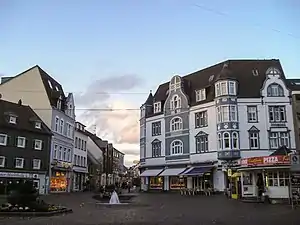Haan
Haan is a town in the district of Mettmann, in North Rhine-Westphalia, Germany. It is situated at the western edge of the Bergisches Land, 12 km southwest of Wuppertal and 17 km east of Düsseldorf. In 1975, Gruiten was incorporated into Haan.
Haan | |
|---|---|
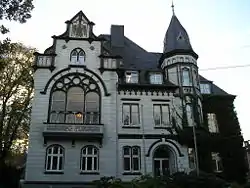 Town hall | |
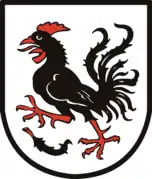 Coat of arms | |
Location of Haan within Mettmann district 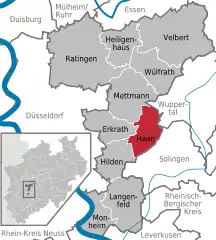 | |
 Haan  Haan | |
| Coordinates: 51°10′N 7°00′E | |
| Country | Germany |
| State | North Rhine-Westphalia |
| Admin. region | Düsseldorf |
| District | Mettmann |
| Subdivisions | 2 |
| Government | |
| • Mayor | Dr. Bettina Warnecke |
| Area | |
| • Total | 24.22 km2 (9.35 sq mi) |
| Elevation | 160 m (520 ft) |
| Population (2019-12-31)[1] | |
| • Total | 30,406 |
| • Density | 1,300/km2 (3,300/sq mi) |
| Time zone | UTC+01:00 (CET) |
| • Summer (DST) | UTC+02:00 (CEST) |
| Postal codes | 42781 |
| Dialling codes | 02129, 02104 |
| Vehicle registration | ME |
| Website | www.haan.de |
History
Haan's origins date back to around 2200 BC. Dated BC. At that time, a hail-shaped settlement was founded in today's city center, which is equipped with a rampart, palisade fence and hedging strips. Accordingly, the name "Haan" should be derived from Hagen, with a reorganization analogous to grove.
From 718 AD Haan was close to the Saxon-Franconian border running between Sonnborn and Elberfeld (both today in Wuppertal). Since today's Kaiserstrasse was a route for the Franconian troops to the east, a marketing system (sutlers) was created in Haan to supply the soldiers.
Even before the early High Middle Ages, Haan belonged to the Archdiocese of Cologne together with Hilden and, even after the formation of the county and later the Duchy of Berg, was initially one of the enclaves within this territorial area. Already around 850 a pre-Romanesque chapel or church was built on the old church square, which Archbishop Wichfried von Köln consecrated in 935. At that time this church was subordinate to the main church in Hilden.
In 1386 the road from Hilden via Haan to Elberfeld, today's federal road 228, was first mentioned in a document. The first evidence of the grinding and weaving trade, which was widespread in Haan until the 20th century, can be dated back to 1589 and 1724 respectively.
In the second half of the 16th century the church of Haan was reformed by the Evangelicals.
Until 1806, Haan, Obgruiten and Gruiten belonged to the Amt Solingen, Ellscheid to the Amt Mettmann within the Duchy of Berg. In 1808, the towns of Haan, Ellscheid, Millrath (today Erkrath), Gruiten, Schöller and Sonnborn (both today Wuppertal) came under French rule and were united to form "Mairie Haan". In 1815 this Mairie was placed under Prussian administration and rededicated to a Prussian mayor's office. [6] At that time, the Mayor's Office (no real office, in German: Bürgermeisterei) of Haan included the following seven special household parishes: Parish Haan, Honschaft Ellscheid, Honschaft Millrath, Honschaft Gruiten, Honschaft Schöller, Honschaft Obgruiten and Kirchspiel Sonnborn.
In 1841, with the completion of the Elberfeld — Gruiten — Düsseldorf railway line, Haan was connected to the ever-expanding rail network. Another connection followed in 1867 with the Ohligs-Gruiten line.
In the same year Sonnborn retired from the Haan mayor's office (Bürgermeisterei). In 1894 Haan left the mayor's office and Millrath, Gruiten and Schöller henceforth formed the mayor's office, later Amt Gruiten.
In 1899 Haan got connection to the tram connection from Benrath (today to Düsseldorf) via Hilden to Vohwinkel (today to Wuppertal). City rights were granted to Haan in 1921.
At the turn of 1944/1945, World War II left visible traces in the cityscape when residential areas in Upper and Middle Haan were bombed on New Year's and New Year's Day. 70 people were killed. [2] On April 16, 1945, US-american troops entered Haan, which were replaced by British forces in July 1945.
In 1956, the Catholic parish replaced its neo-Gothic church from 1869 with the modern St. Chrysanthus and Daria church.
Since July 14, 2017, Haan has had the addition of the name "Garden City" to the state of North Rhine-Westphalia in accordance with section 13 (3) of the municipal code. The city had previously described itself as a “garden city”. In the 19th century, deep garden areas were assigned to the residential buildings; Seed trading played an important role in the urban economy.
Population development
(each on December 31)
1996: 28,996 inhabitants
1997: 29,213 "
1998: 29,452 "
1999: 29,525 "
2000: 29,677 "
2001: 29,607 "
2002: 29,518 "
2003: 29,472 "
2004: 29,370 "
2005: 29,325 "
2006: 29,411 "
2007: 29,323 "
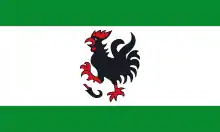
2008: 29,149 "
2009: 30,074 "
2010: 29,149 "
2011: 30,257 "
2012: 29,848 "
2013: 29,985 "
2014: 30,811 "
2015: 31,137 "
2016: 31,230 "
2017: 31,265 "
International relations
Haan is twinned with:
 Eu, France, since 1967
Eu, France, since 1967 Berwick-upon-Tweed, United Kingdom, since 1982
Berwick-upon-Tweed, United Kingdom, since 1982 Bad Lauchstädt, Germany, since 1990
Bad Lauchstädt, Germany, since 1990 Dobrodzień, Poland, since 2004
Dobrodzień, Poland, since 2004
The local Gymnasium is also twinned with Liceo Scientifico of ![]() Forte dei Marmi, Italy.
Forte dei Marmi, Italy.
Economy
References
- "Bevölkerung der Gemeinden Nordrhein-Westfalens am 31. Dezember 2019" (in German). Landesbetrieb Information und Technik NRW. Retrieved 17 June 2020.
